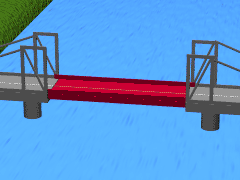Vertical-lift bridge
A vertical-lift bridge or lift bridge is a type of movable bridge in which a span rises vertically while remaining parallel with the road surface.

The vertical lift offers several benefits over other movable bridges such as the bascule and swing-span bridge. They are generally easier to design and easier to build.[1] They usually cost less to build for longer moveable spans.[2] The counterweights in a vertical lift bridges are only required to be equal to the weight of the deck.[1] Bascule bridge counterweights must weigh several times as much as the span being lifted. As a result, heavier materials can be used in the deck, and so this type of bridge is especially suited for heavy railroad use.[1]
Although most vertical-lift bridges use towers, each with counterweights. Some use hydraulic jacks located below the deck. An example is the 52-foot (16 m) span bridge at St Paul Avenue in Milwaukee, Wisconsin, USA.[3] Another design used balance beams to lift the deck with pivoting bascules located on the top of the lift towers.[4] An example of this kind is the La Salle Street Bridge in Chicago, Illinois, USA.
The biggest disadvantage to the vertical-lift bridge is the height restriction for ships passing under it. This is a result of the deck remaining suspended above the water.
References
change- ↑ 1.0 1.1 1.2 Terry L. Koglin, Movable Bridge Engineering (Hoboken, NJ: J. Wiley & Sons, 2003), p. 76
- ↑ Leonardo Fernandez Troyano, Bridge Engineering: A Global Perspective (London: Telford, 2003), p. 731
- ↑ Leonardo Fernandez Troyano, Bridge Engineering: A Global Perspective (London: Telford, 2003), p. 729
- ↑ Leonardo Fernandez Troyano, Bridge Engineering: A Global Perspective (London: Telford, 2003), p. 732